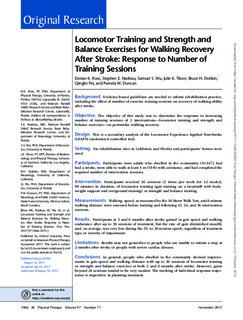| dc.contributor.author | Rose, Dorian K. | |
| dc.contributor.author | Nadeau, Stephen E. | |
| dc.contributor.author | Wu, Samuel S. | |
| dc.contributor.author | Tilson, Julie K. | |
| dc.contributor.author | Dobkin, Bruce H. | |
| dc.contributor.author | Pei, Qinglin | |
| dc.contributor.author | Duncan, Pamela W. | |
| dc.date.accessioned | 2019-02-27T08:32:46Z | |
| dc.date.available | 2019-02-27T08:32:46Z | |
| dc.date.issued | 2017 | |
| dc.identifier.citation | Dorian K. Rose, Stephen E. Nadeau, Samuel S. Wu, Julie K. Tilson, Bruce H. Dobkin, Qinglin Pei, Pamela W. Duncan; Locomotor Training and Strength and Balance Exercises for Walking Recovery After Stroke: Response to Number of Training Sessions, Physical Therapy, Volume 97, Issue 11, 1 November 2017, Pages 1066–1074. | nb_NO |
| dc.identifier.uri | http://hdl.handle.net/11250/2587673 | |
| dc.description.abstract | Background
Evidence-based guidelines are needed to inform rehabilitation practice, including the effect of number of exercise training sessions on recovery of walking ability after stroke.
Objective
The objective of this study was to determine the response to increasing number of training sessions of 2 interventions—locomotor training and strength and balance exercises—on poststroke walking recovery.
Design
This is a secondary analysis of the Locomotor Experience Applied Post-Stroke (LEAPS) randomized controlled trial.
Setting
Six rehabilitation sites in California and Florida and participants’ homes were used.
Participants
Participants were adults who dwelled in the community (N=347), had had a stroke, were able to walk at least 3 m (10 ft) with assistance, and had completed the required number of intervention sessions.
Intervention
Participants received 36 sessions (3 times per week for 12 weeks), 90 minutes in duration, of locomotor training (gait training on a treadmill with body-weight support and overground training) or strength and balance training.
Measurements
Talking speed, as measured by the 10-Meter Walk Test, and 6-minute walking distance were assessed before training and following 12, 24, and 36 intervention sessions.
Results
Participants at 2 and 6 months after stroke gained in gait speed and walking endurance after up to 36 sessions of treatment, but the rate of gain diminished steadily and, on average, was very low during the 25- to 36-session epoch, regardless of treatment type or severity of impairment.
Limitations
Results may not generalize to people who are unable to initiate a step at 2 months after stroke or people with severe cardiac disease.
Conclusions
In general, people who dwelled in the community showed improvements in gait speed and walking distance with up to 36 sessions of locomotor training or strength and balance exercises at both 2 and 6 months after stroke. However, gains beyond 24 sessions tended to be very modest. The tracking of individual response trajectories is imperative in planning treatment. | nb_NO |
| dc.publisher | Physical Therapy | nb_NO |
| dc.subject | locomotor training | nb_NO |
| dc.subject | strength | nb_NO |
| dc.subject | balance exercises | nb_NO |
| dc.subject | walking recovery | nb_NO |
| dc.subject | stroke | nb_NO |
| dc.title | Locomotor Training and Strength and Balance Exercises for Walking Recovery After Stroke: Response to Number of Training Sessions | nb_NO |
| dc.type | Journal article | nb_NO |
| dc.source.pagenumber | 1066-1074 | nb_NO |
| dc.source.volume | 97 | nb_NO |
| dc.source.journal | Physical Therapy | nb_NO |
| dc.source.issue | 11 | nb_NO |
| dc.identifier.doi | https://doi.org/10.1093/ptj/pzx079 | |
| dc.description.localcode | måsjekkes | |
